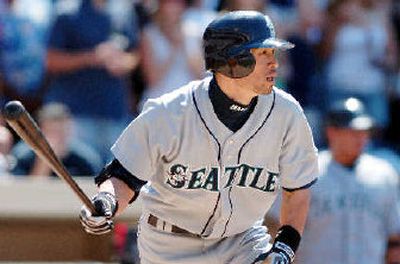Ichiro’s drop-off barely qualifies as slump

SAN JOSE, Calif. – Ichiro Suzuki is in a batting slump, which is akin to saying that a fish is in a swimming slump or that Angelina Jolie is in a tabloid slump. It’s simply inconceivable.
Since arriving in the big leagues in 2001, Ichiro has produced line drives so naturally – or supernaturally, in the case of last season – it seemed unlikely that pitchers would figure him out.
But the numbers speak for themselves, and apparently they speak Japanese:
Ichiro hit .288 in May.
He hit .243 in June.
While in Oakland last week, Seattle Mariners manager Mike Hargrove said he was unfazed by his leadoff hitter’s quiet bat.
“With a player of his caliber, one game, one at-bat, one swing can be all it takes to get turned around,” Hargrove said. “The last four or five days, he’s been swinging the bat better.”
A scout for a National League team, however, said he sees signs of trouble. He said pitchers have solved Ichiro – at least temporarily – with an old-fashioned strategy: Opponents are busting him inside with four-seam fastballs.
“I didn’t think you could get him inside like that, but teams are doing it,” he said. “He’s trying to pull even the outside pitches now, and you’re seeing a lot of weak groundballs to second. Essentially, what teams are doing is taking away half the field.”
In previous years, the scout said, Ichiro would wait for a pitch on the outside part of the plate and serve it to the opposite field. Sometimes a deep groundball to short was all it took. Ichiro led the majors with 57 infield hits in 2004.
Opponents have tried busting Ichiro inside before, the scout said, but the strategy fizzled.
“Most pitchers don’t know how to pitch inside,” he said. “Either they can’t do it or they’re afraid.”
Hargrove dismissed the theory.
“I don’t think guys are pitching him any differently,” he said. “He’s been hitting the ball better. The hits just aren’t falling for him.”
During his first four seasons, Ichiro’s hits fell like rain. His 924 hits during that span are more than any other player over four consecutive seasons. (Bill Terry had the previous best with 918 in 1929-32. That was in the days of a 154-game schedule.)
Ichiro set a record with 262 hits last season, 46 more than runner-up Michael Young of the Texas Rangers. That was the largest differential between a league leader and a runner-up, topping the 44 by Stan Musial (228) over Dixie Walker (184) in the 1946 National League race.
Ichiro has been streaky before. Even during his sizzling 2004 season, he hit .255 in April, .400 in May, .274 in June and .432 in July.
That’s not exactly Mr. Consistency.
But two consecutive down months? Ichiro even had an incredible 0 for 6 on June 22 against the A’s.
Ichiro is unfazed. Through a translator, he recently laughed off his statistics to Sports Illustrated by saying, “Maybe it’s because I ate too much Jell-O or put too much wasabi on the food that I eat. You never know.”
There are signs that he is adjusting to the latest pitching patterns. On Tuesday, against A’s left-hander Barry Zito, Ichiro ignored the first pitch, a fastball off the outside corner. Then when Zito then tried to come inside with a fastball – as most teams are doing – Ichiro drilled it for his third leadoff home run of the season.
That’s part of the reason some opponents think talk of Ichiro’s slump is much ado about nothing. When asked what’s wrong with Ichiro, A’s manager Ken Macha answered with a question of his own.
“What’s he hitting?” he replied dryly.
Ichiro is hitting .301. It’s a slump most hitters would love to have.